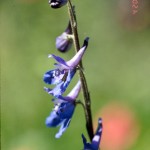Larkspur
Delphinium spp.
Description
Larkspurs are perennial herbs growing 1 to 3 feet or 0.3 to 0.9 m tall. The leaves are deeply divided into numerous lobed segments and are usually confined to the bottom half of the plant. Showy, light blue, blue, purple, or white flowers are arranged along the top of the erect stalk. The distinguishing characteristic of the flower is the prominent backward trailing narrow, terminal spike or spur.Habitat
One or more species of Delphinium may be found in open pastures, hillsides, brushlands, or valleys of all vegetational areas of Texas.Toxic Agent
More than 40 different diterpenoid alkaloids have been identified from Delphinium spp., but most of these are from the tall Larkspurs of the mountains in the western United States. Toxicity varies greatly among species, as does the concentration of toxins. Usually, alkaloid concentrations are highest in the spring after flowering and gradually decrease as the plant matures. All parts of the plant should be considered toxic, but new growth and seeds typically contain the highest concentrations of toxins. All species of livestock may be affected, though cattle are the most susceptible. Texas Larkspur species are small plants with scant foliage, and poisoning is uncommon. Despite this, all Larkspurs should be considered potentially toxic.Signs of Livestock Ingestion
Larkspur primarily affects the neuromuscular system and consequent signs of poisoning include Salivation; Lateral Recumbency; Stiff gait; Collapse, followed by a struggle to regain feet; Muscular twitches; Death. Within hours of consumption, death can occur from either paralysis of the respiratory system or asphyxiation caused by bloating or vomiting.Management Strategies
Larkspur poses the greatest risk to livestock in the spring. Losses in heavily infested areas may be reduced by keeping cattle out of pastures until after the plants have flowered and gone to seed, or by grazing sheep, which are more resistant, before cattle. Sheep and horse losses rarely occur, but if subjected to sudden strenuous activity after consuming large amounts of larkspur, it may result in death. Because treating larkspur with some herbicides increases its palatability, do not use treated pastures for grazing until the affected plants are dead.Images
Plant Characteristics
Flower Color: Blue, Purple, White
Seed Type: Non-Encapsulated
Duration: Perennial
Stem Texture: Hairless/Smooth
Growth Habit: Forbs/Broadleaf
Season: Warm
Distribution
 : 01 - Pineywoods, 02 - Gulf Prairies and Marshes, 03 - Post Oak Savannah, 04 - Blackland Prairies, 05 - Cross Timbers and Prairies, 06 - South Texas Plains, 07 - Edwards Plateau, 08 - Rolling Plains, 09 - High Plains, 10 - Trans-Pecos
: 01 - Pineywoods, 02 - Gulf Prairies and Marshes, 03 - Post Oak Savannah, 04 - Blackland Prairies, 05 - Cross Timbers and Prairies, 06 - South Texas Plains, 07 - Edwards Plateau, 08 - Rolling Plains, 09 - High Plains, 10 - Trans-Pecos
Distributions
Distribution refers to the ecological region in Texas that a plant has been found. You can also view a clickable map.
Book: Toxic Plants of Texas (B-6105)
Collection: Toxics, Wild Flowers
Livestock Affected: Cattle, Goats, Horses, Sheep
Livestock Signs: Abnormal Heartbeat, Arched Back, Bloat and Pulmonary Congestion, Collapse, Excess Salivation, Excitability, Incoordination, Muscular Twitching, Stiffness, Sudden Death, Trembling, Vomiting/Regurgitation






